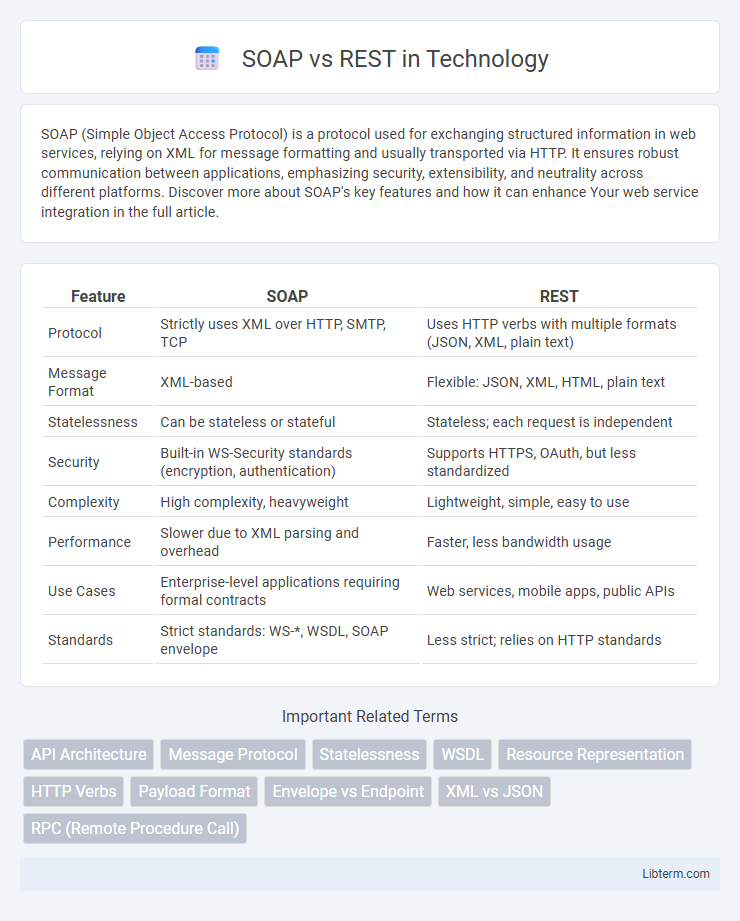SOAP (Simple Object Access Protocol) is a protocol used for exchanging structured information in web services, relying on XML for message formatting and usually transported via HTTP. It ensures robust communication between applications, emphasizing security, extensibility, and neutrality across different platforms. Discover more about SOAP's key features and how it can enhance Your web service integration in the full article.
Table of Comparison
| Feature | SOAP | REST |
|---|---|---|
| Protocol | Strictly uses XML over HTTP, SMTP, TCP | Uses HTTP verbs with multiple formats (JSON, XML, plain text) |
| Message Format | XML-based | Flexible: JSON, XML, HTML, plain text |
| Statelessness | Can be stateless or stateful | Stateless; each request is independent |
| Security | Built-in WS-Security standards (encryption, authentication) | Supports HTTPS, OAuth, but less standardized |
| Complexity | High complexity, heavyweight | Lightweight, simple, easy to use |
| Performance | Slower due to XML parsing and overhead | Faster, less bandwidth usage |
| Use Cases | Enterprise-level applications requiring formal contracts | Web services, mobile apps, public APIs |
| Standards | Strict standards: WS-*, WSDL, SOAP envelope | Less strict; relies on HTTP standards |
Introduction to SOAP and REST
SOAP (Simple Object Access Protocol) is a protocol designed for exchanging structured information in web services using XML, emphasizing strict standards for security, reliability, and messaging. REST (Representational State Transfer) is an architectural style that leverages standard HTTP methods and focuses on stateless client-server communication, utilizing various data formats like JSON and XML. SOAP supports complex operations with built-in WS-* standards, while REST prioritizes scalability and simplicity in API design.
Core Principles of SOAP
SOAP operates on a set of core principles including extensibility, neutrality, and independence, which enable it to support complex operations through structured XML messaging. It relies on protocols like HTTP, SMTP, and TCP, ensuring platform and language neutrality for seamless integration across diverse systems. The strict contract-based communication using WSDL enhances reliability, security, and formal message exchange in enterprise environments.
Core Principles of REST
REST is based on stateless client-server architecture, where each request from client to server must contain all the information needed to understand and process the request. It emphasizes a uniform interface using standard HTTP methods like GET, POST, PUT, and DELETE to manipulate resources represented as URLs. REST also promotes cacheability, layered system architecture, and a client-server separation that enhances scalability and flexibility in web services.
Message Format and Data Exchange
SOAP uses XML exclusively for message format, enforcing strict standards and allowing complex operations with built-in error handling and security through WS-* protocols. REST supports multiple message formats like JSON, XML, or plain text, enabling lightweight, flexible data exchange over HTTP using standard methods such as GET, POST, PUT, and DELETE. SOAP's rigid structure suits enterprise-level services requiring formal contracts, while REST's simplicity and versatility optimize performance for web and mobile applications.
Security Mechanisms
SOAP employs WS-Security standards, offering robust features like message encryption, digital signatures, and token-based authentication to ensure end-to-end message integrity and confidentiality. REST typically relies on HTTPS for transport-layer security, and can implement OAuth, API keys, or JWTs for authentication and authorization, though it lacks a universal security specification like WS-Security. SOAP's security mechanisms are better suited for enterprise environments requiring strict compliance, while REST's simpler approach is commonly adopted for web and mobile applications where speed and scalability are priorities.
Performance and Scalability
REST typically outperforms SOAP in terms of speed and scalability due to its lightweight nature and stateless architecture, which reduces server load and improves response times. SOAP's extensive XML messaging and built-in error handling result in higher overhead, potentially slowing performance under heavy loads. REST's use of caching mechanisms and flexible data formats like JSON further enhances scalability, making it the preferred choice for high-traffic applications.
Flexibility and Extensibility
SOAP provides rigid standards with built-in security and transaction compliance, making it less flexible but highly extensible for enterprise-level applications requiring formal contracts. REST offers greater flexibility by utilizing stateless communication and diverse data formats like JSON and XML, enabling easier integration and faster development in web services. The extensibility of REST is driven by its resource-based architecture, allowing scalable evolution without strict protocols, whereas SOAP's extensibility depends on predefined WSDL contracts.
Use Cases for SOAP
SOAP excels in enterprise-level applications requiring high security, such as banking and financial services, where strict ACID compliance and transactional reliability are essential. It is ideal for distributed environments with complex operations and formal contracts defined via WSDL. SOAP's built-in error handling and support for WS-Security make it suitable for scenarios demanding message-level security and compliance.
Use Cases for REST
REST is widely used for web and mobile applications requiring scalable, lightweight communication and quick data exchange, such as social media platforms, e-commerce sites, and IoT devices. Its stateless architecture and support for multiple data formats like JSON make REST ideal for real-time data updates and integration with cloud services. REST APIs are favored for their simplicity, flexibility, and broad compatibility with modern web technologies compared to SOAP's rigid protocol.
Choosing Between SOAP and REST
Choosing between SOAP and REST depends on the application requirements and system architecture. SOAP offers robust security features, built-in error handling, and a standardized protocol ideal for enterprise-level transactions requiring ACID compliance and formal contracts. REST is favored for web-scale applications due to its simplicity, scalability, statelessness, and support for multiple data formats like JSON and XML, making it suitable for cloud services and mobile applications.
SOAP Infographic

 libterm.com
libterm.com